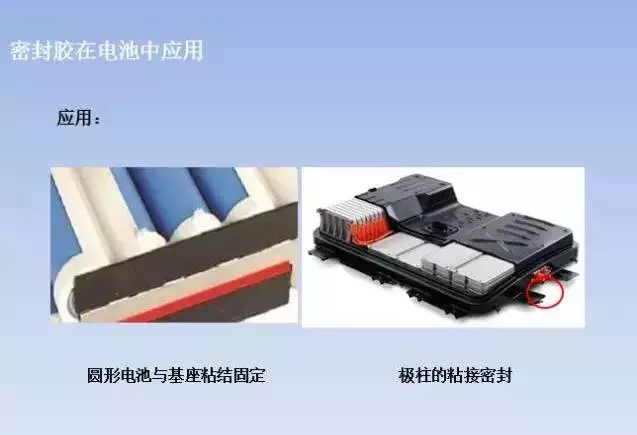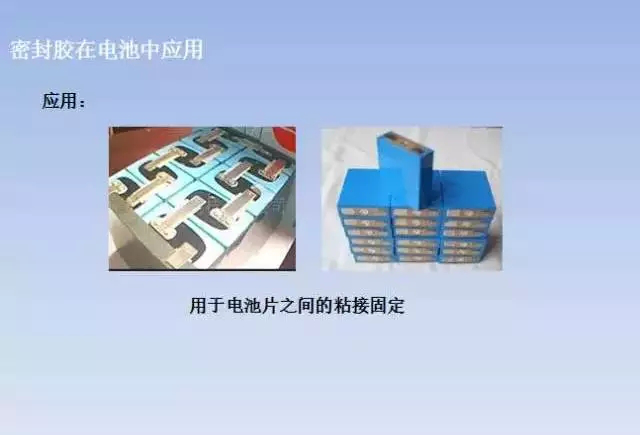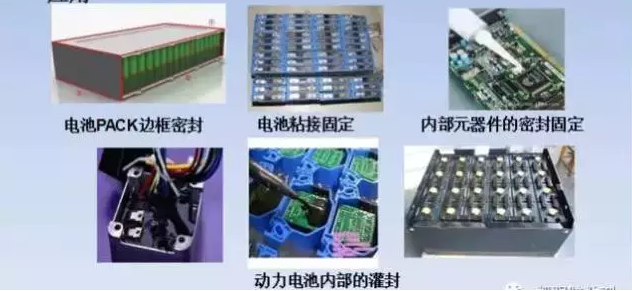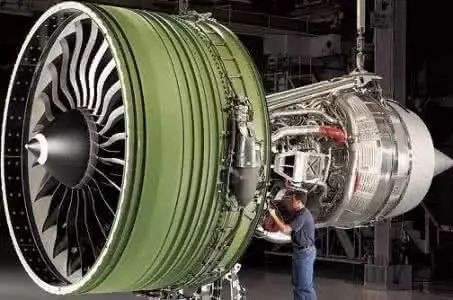Introduction of Adhesive for Power Battery of New Energy Vehicle and Its Application
At present, the use of automobiles is increasing. New energy electric vehicles are a mainstream trend to solve problems of energy, environment, and urban transportation, as well as a main direction for the future development of the automobile industry. However, the safety of new energy vehicles has attracted more and more attention. Today, the editor will introduce the glue for new energy vehicle power battery and its application.
With the rapid development of new energy vehicles, reports of new energy vehicles on fire are often seen in the newspapers. The safety of new energy vehicles has attracted more and more public attention

As the source of power for new energy vehicles, the failure of power batteries is the beginning of safety. About 80% of new energy vehicles are troubleshooting power batteries. The investigation found that the reasons for the battery failure are as follows:
·Battery leakage
·Partial short circuit
·Insulation damage
When the battery is impacted by an external force, the above-mentioned problems may occur when the battery is overcharged and discharged, which may cause fire and explosion accidents.
solution:
Sealant has excellent performance. In order to solve the safety problem of power battery, it needs to be comprehensively considered from several aspects such as anti-collision, anti-vibration, flame-retardant, reliability, and waterproof.
·Anti-collision and anti-vibration: Since the cells inside the battery are not fixed, they are easily deformed and moved when subjected to impact, causing short circuits and battery liquid corrosion.
·Flame-retardant: There are multiple cells inside the battery. When one is on fire, it will cause others to catch fire. The fire-retardant treatment can effectively reduce the fire phenomenon.
·Heat conduction: The internal structure of the power battery is concentrated, the power is large, the heat dissipation is high, and the thermal conductivity of the air is small, it is easy to cause heat accumulation, which will reduce the battery life
·Waterproof: Moisture inside the power battery will cause degradation and cause a short circuit
Application of sealant in batteries:
There are three types of sealant for power battery: butyl ester sealant, epoxy sealant, silicone sealant
Acrylic sealant:
·Polyamide has high strength, up to 20MPa
·Widely applicable substrates: metal and non-metal
·Quick curing at room temperature: 315min
·Resistant to certain impact
·The maximum operating temperature does not exceed 120℃

Acrylic sealant used in batteries
Epoxy sealant:
>High asphalt strength, 5-20MPa
>A wide range of substrates: ceramic, metal, glass, plastic, rubber, paper, cloth, etc.
>Quick curing at room temperature
>Resistant to certain impact
>Working temperature -30-120℃

Application of epoxy sealant in batteries
Silicone sealant:
Silicone is a kind of polymer material based on the main chain of sO chain link
>Excellent high and low temperature resistance (60-260℃)
>Good weather resistance
>Electrical insulation (volume resistivity up to 1×101416gcm)
>It is an elastomer after curing, with good shock and shock resistance
>The anisotropy coefficient reaches 0203Wm·K (air is 0.023Wm·K), the increase rate can be significantly increased after adding transparent filler
>Good flame retardancy. The combustion temperature is about 430°C, and the flame temperature reaches 750°C. After burning, sio2 is generated, no corrosive gas. After adding flame retardant filler, it can reach ∨-0 flame retardant grade. Test method: The sample is carried out twice 10 Second combustion test, the flame is extinguished within 30 seconds, no burning material falls. When a battery cell catches fire, it can surround the surrounding battery cell to catch fire
>Good water vapor transmission rate. PAcK sealed by silicone sealant can pass the P67 waterproof test method: completely immerse the sealed PAcK in a water tank, and after continuous soaking at the top of 05-1m from the water surface for 30 minutes, there is no change in performance. Water enters the inside of the PAcK. Can effectively prevent the penetration of water vapor into the battery
>Good resonance, the resonance coefficient reaches 020.3Wm·K (air is 0.023Wm·K), and the conversion rate after replacing the filler can be increased significantly, which can effectively transfer the transmission generated inside the battery to the surface, reducing accumulation and improving the battery Life, silicone sealant has excellent performance, can meet the shockproof, waterproof, flame-retardant, and conductive needs of power batteries, can meet the use of automobiles under different climatic conditions, and effectively improve the safety of power batteries.

Application of silicone sealant in batteries
Introduction of Adhesive for Power Battery of New Energy Vehicle and Its Application
Adhesives have been used more and more widely in aerospace products, mainly because aerospace products mostly use light alloys, honeycomb structures and composite materials. However, aerospace products are used in harsh environments and have higher requirements for glue and need to be able to withstand ultra-high temperatures. , Temperature change, high vacuum, ultra-low temperature, thermal cycle, ultraviolet light, charged particles, micrometeorites, atomic oxygen and other environmental tests. Specifically for the use of glue in the aerospace industry, the Adhesives Research Institute has developed more than 100 kinds of special adhesives and sealants, mainly including polyurethanes, phenolic resins, epoxy resins, silicones, acrylics, and organic boron. Most of these adhesives have been used in my country’s aerospace products such as launch vehicles, satellites and spacecraft.

Here we mainly introduce high temperature and low temperature resistant adhesives
1. High temperature resistant adhesive
High temperature resistant adhesives generally refer to adhesives that can be used at temperatures above 150°C. Such adhesives mainly include modified polyfunctional epoxy resins (EP), phenolic resins, silicon (or boron) polymers, aromatic heterocyclic high temperature resistant polymers and inorganic adhesives.
PI adhesive is the earliest developed, most widely used and best comprehensive performance high temperature resistant structural adhesive. After curing at 300℃, it has good heat resistance and shear strength under 300℃~400℃. It can be used for a long time at 230℃ and can withstand high temperature of 550℃ in a short time. It has good low temperature resistance, solvent resistance, abrasion resistance, flame retardancy and very low thermal expansion coefficient. The shear strength of the polyether ether ketone imide adhesive developed by Jilin University exceeds 13 MPa at room temperature and 150°C.
Bismaleimide (BMI) is a kind of cross-linked PI with excellent performance. It has both PI's excellent high temperature resistance and moisture resistance. When BMI is introduced into epoxy resin, due to the different polymerization mechanism and compatibility of the two, an interpenetrating network structure or two-phase system may be formed during the polymerization process, thereby achieving the purpose of toughening and improving heat resistance. . The cyanate ester modified BMI adhesive can work for a long time at 230℃, and the shear strength is above 13MPa. Adhesive J-223 for high temperature radome can be cured at 100℃, and the shear strength is 0.5MPa at 500℃.

The application of adhesives in the aerospace industry
2. Low temperature resistant adhesive
Low temperature resistant adhesive refers to an adhesive that can be used in ultra-low temperature environments and has sufficient strength. It is usually made of PU, EP modified PU, PU and PA modified EP and other main materials. At present, the low-temperature adhesives used in aerospace products in China that can be used at -253℃ mainly include NHJ-44 developed by the Institute of Aerospace Materials and Technology for the bonding of the common bottom and the insulation layer of the carrier rocket liquid hydrogen and liquid oxygen tank. Glue, polyurethane modified epoxy glue, DWJ-46 glue that matches the expansion coefficient of polyimide and aluminum tank, etc. The performance index of NHJ-44 glue is completely consistent with the US Federal Standard MMMA-132Al structural glue. Low-temperature thermally conductive insulating glue for bonding surface temperature sensors of hydrogen and oxygen engines, with a thermal conductivity of 0.63-0.7W/m·K. DW-1 polyether polyurethane glue and DW-3 tetrahydrofuran polyether epoxy glue of Shanghai Institute of Synthetic Resins are also used.
The most widely used in aerospace is the special sealant
Sealants often cannot be prefabricated according to shape and size in advance, so the processability of their use is particularly important. Silicone sealants are widely used in the aerospace industry. Many aerospace products require long-term sealing against 300°C, short-term sealing against 400°C or more, or instantaneous sealing against 1000°C.
At present, there are high-grade single-component and two-component PU sealants in China, which are mainly used for the potting of waterproof electrical connectors, cable ends and plugs, circuit boards and other electrical components of aerospace products.

The application of adhesives in the aerospace industry
Although significant progress has been made in the development of adhesives for aerospace products, some key materials needed by the aerospace industry still rely on imports, and the performance and quality of some materials are not stable. Future lunar exploration projects, long-term space stations, There will be many new demands for special adhesives in aerospace engineering such as deep space exploration, which require the continued efforts of scientific and technological workers engaged in the preparation and application of adhesives.
 Scan and pay attention
Scan and pay attention
 Wechat consulting
Wechat consulting